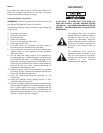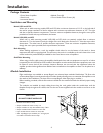
Panel Descriptions
Power Vector Rear Panel
1.AC Receptacle
A grounded, unswitched AC convenience receptacle with a 500W maximum capacity is provided for external
equipment.
2.AC Line Cord and Circuit Breaker
A grounded, 3-wire AC line cord provides power to the amplifier and is protected by a resettable circuit
breaker.
3.Trans Output / Direct Out Selector
Allows selection of either transformer-coupled outputs (70V, 25V, and 8-ohm) or a direct low-impedance
(4-ohm minimum) output.A locking device is included to avoid accidental switching.
4. Speaker Output Barrier Strip
A 5-position barrier strip, with clamping washers, provides connections for speaker loads.
5. Mute Control Terminals
Provides access to mute buses for external control and system expansion.
6. Remote Volume Control Terminals
Three terminals are provided for connection of a remote station to control the amplifier’s motorized Master
Volume Control.
7. Low-Cut Switch
A slide switch (located in module bay 6) that allows roll off of frequencies below 125 Hz.
8.Tone Control Bypass Switch
A slide switch (located in module bay 6) that allows the effects of the bass and treble controls to be bypassed.
9. Module Bays
The amplifier has eight module bays, all of which can accommodate input modules, with two bays (bays 7
and 8) that can accommodate either input or output modules.
10. Bridging Jack
An RCA connector that allows the bridging of Power Vectors together for system expansion.
11. Pre-EQ Output
An unbalanced RCA buffer output whose signal includes all volume controls, tone controls, and output module
signal processing, but before (pre-EQ) any external signal-processing equipment connected to the Signal-
Processing Insert jacks.
12. Insert Jacks
A pair of RCA connectors allow external equipment to be inserted between the pre-amp output and the power
amp input. Inserting a plug into the jack labeled “IN” automatically breaks the internal connection between the
amplifier’s pre-amp section and power amp section.The insert connections are unbalanced.
3


















